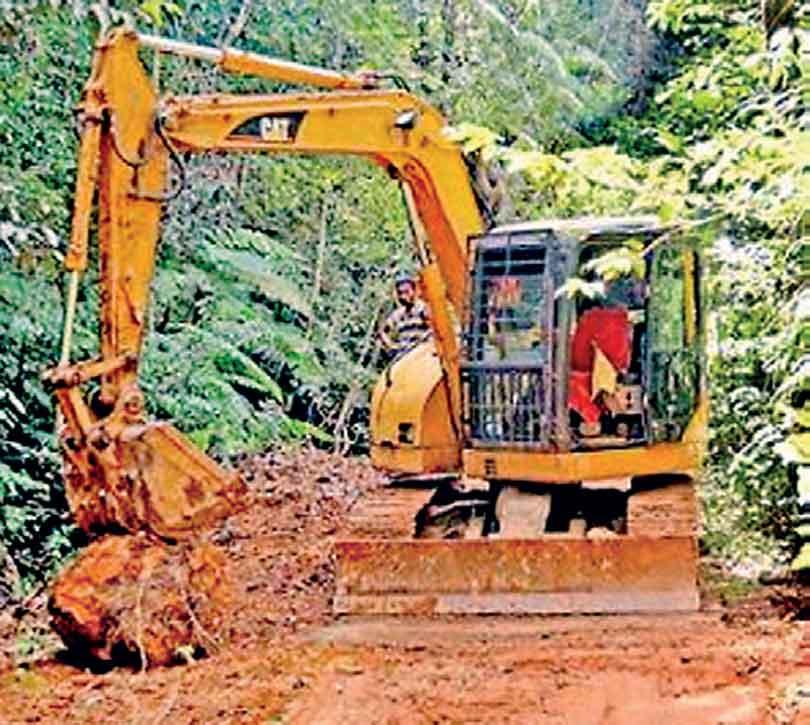Reply To:
Name - Reply Comment

 The environmentalists have come up with a fretful confrontation with the government over the Sinharaja issue. This irritable attitude of environmentalists is justifiable with what is said and done so far by the government regarding the few environmental issues arose after the new regime came in to power. There is no need for further talks with the government if it sees, that it is an advantage to keep away those who are generally accepted as “environmentalists” without giving them the slightest chance to mingle with state decisions. But if otherwise, and the government sees, wining them back would be in benefit to the authority, this is a very short note on how to do it.
The environmentalists have come up with a fretful confrontation with the government over the Sinharaja issue. This irritable attitude of environmentalists is justifiable with what is said and done so far by the government regarding the few environmental issues arose after the new regime came in to power. There is no need for further talks with the government if it sees, that it is an advantage to keep away those who are generally accepted as “environmentalists” without giving them the slightest chance to mingle with state decisions. But if otherwise, and the government sees, wining them back would be in benefit to the authority, this is a very short note on how to do it.
As soon as the new regime came in to power, the requirement to obtain a licence to transport sand was abolished for a trail period. The trail period was terminated recently and the old regulations have been reinstated now. But within the very short period of time where the license requirement was absent , a number of pristine estuaries were completely destroyed. Even though the license attached to the transportation of sand was nullified , the other license which is mandatory to be obtained before mining from a site was kept intact. It was surprising and shocking to see, many river banks and estuaries had been acquired by large groups of villagers who were busy with heavy machinery extracting sand. Does this mean that sand mining sites were not properly inspected and regulated by relevant authorities during that time? Hence we understand that, cancelling the transportation license did not only mean cancelling the said license but it essentially meant neglecting the entire legal procedure pertaining to sand mining.
According to the government, the widening of the road from Neluwa to Lankagama is solely done on the request made by the villagers
‘Sand mining issue’ was followed by the “dozer controversy” which has not in fact ended yet. The first incident was the demolishing of “Buwaneka Raja Mandapaya” in Kurunegala with the use of a bulldozer, and as of now, after a sequence of intriguing developments, the driver of the heavy machinery has been arrested and kept under custody. Within the very next week, the media reported of an illegal reclamation of a plot of land located in the RAMSAR wet land Anawilundawa in Puttalam district. It was revealed that this area has also been cleared and filled with dry soil with the aid of a bulldozar as the police was able to find the machine and get that into custody. This was then followed by the controversy around Sinharaja rain forest. Number of bulldozers were observable along the Neluwa- Lankagama road, excavating and widening it. This reaffirmed the humorous sentiment among masses, that every sin against environment and national heritage of this country is committed by bulldozers, and hence all of them must be arrested and kept in custody.
There is no need to discuss the issue of Sinharaja at length since it has already been conferred enough. The first thing the government and her law enforcement agencies should do is clearly demarcating the existing boundaries of the forest reserve. Then all the illegal settlements and plantations should be removed in accordance with the law. This should be followed by a very salient decision afterwards; that is the publishing and activating the gazette signed by former President Maithripala Sirisena (also as the then environment minister) expanding the borders of Sinharaja forest reserve to include all the surrounding rain forests under one protected area. This will result in multiplying the area of the forest reserve approximately three fold, compared to the present size. Afterwards, the other brilliant decision taken by the same, that is to absorb all the forest land in adjacent areas of Sinharaja which are under the patronage of Land reforms commission, must be realized at the earliest. This will add up about another 3000 hectares to the forest reserve.
It is only after fulfilling these mandatory and minimum requirements pertaining to the preservation of the forest reserve, that we can contemplate on a long lasting sustainable solution for the matter .What was the actual dispute that took place and what are the resolutions that we can suggest?
According to the government, the widening of the road from Neluwa to Lankagama is solely done on the request made by the villagers. In contrast to this, environmentalists foresee this as the beginning of the end of Sinharaja which is essentially entangled with vested interests of other parties not visible to the general public. The purview of the environmentalists shall not be easily overlooked since a road has always been the founding stone of an established human settlement. It is not rational to think that a community which has already illegally penetrated the protected area with plantations and habitats would not encroach further in to the forest when the accessibility is increased by constructing a carpeted road. It was a road which penetrated Wilpattu National Park that facilitated human settlers to build their habitats inside the forest reserves which gave birth to the infamous “Wilpattu controversy”. Therefore it is formidable to think that the widening and carpeting of the road in between Neluwa and Lankagama would too put the safety of the reserve in jeopardy.
Some say that the village of Lankagama should be relocated at a suitable location. Most of the villagers are entangled with the forest, one way or other for their livelihood and therefore the suggestion seems next to impossible when it comes to implementation. Moreover, it is not righteous to remove an entire community from their original rooting when their very existence is dependent upon the environment they live in. But on a another dimension it is also not a wise decision to fulfil all the modern aspirations of villagers whilst allowing them to stay next to the forest reserve. The government’s strategic decision must be reinforced by all these factors and it should be a one which truly identifies the importance of Sinharaja and encourages the preservation of it.
Whatever the critical mass of the country shall say, the bitter truth is that the government needs money to run the country. Allowing the villagers to encroach the forest and make new plantations and local hotels will expand the economic activity of the village. But this expansion of economic activity is negligible when compared to the crisis we face and the size of country’s entire economy. Are these the only ways from which we can make money out of Sinharaja? Of course not!
The rain forest Sinharaja is a gold mine if it is examined from the pragmatic angle. The more profitable act in terms of monetary gain would not be penetrating the jungle with a new road, but expanding the boundaries and preserving it. There are plenty of high end tourists around the world who will be more than willing to get the firsthand experience of being inside one of the finest rain forests in the world. What the government should do is to make an investment which would entrust the safety and public ownership of the jungle as well as provide sufficient funds to preserve it. The government should buy land at the highest possible price from villagers who are willing to sell them after clearly establishing the boundaries of the forest. These land shall then be leased to investors on strict conditions.
If needed, new regulations to ensure that no illegal interference is done by the investors shall also be formed. This whole activity should be implemented and carried out with the close supervision of the government and should be clearly visible to the masses. Acquired land must be scientifically replanted with rain forest fauna to be attached to the forest and a whole new experience of “being in the Sinharaja” shall be articulated as a niche concept for tourism. This sort of tourist packages can be sold at very high prices and if we can be ready at least with the initiation by the end of COVID-19 pandemic, it will surely open doors for a huge economic potential in the future.